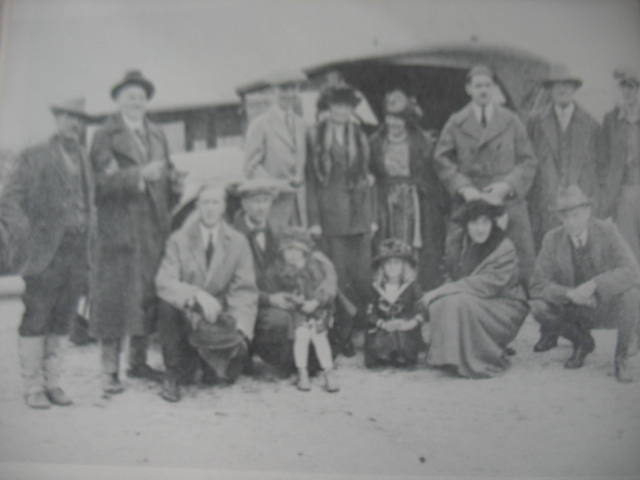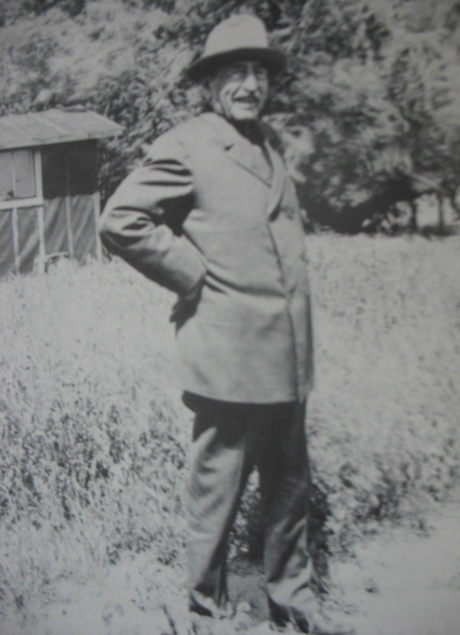In the extensive discussions with the eldest child of Geronimo and Catarina López conducted by the author of Saga of Rancho El Tejón, the final excerpts presented here deal with José Jesús López (also known as J.J.) as he goes to school, takes on early work, and then makes the move to Kern County where he was the foreman of the famed Tejon Ranch for several decades.
After discussing how his father went to the Sierra Nevada mines during the great Gold Rush of 1848, after delivering cattle at what became the town of Sonora in Tuolumne County for Henry Dalton, a Los Angeles merchant and later owner of Rancho Azusa in the eastern San Gabriel Valley, and then married Catarina, J. J. turned his attention to his schooling, principally the Escuela Normal de Los Angeles, which he attended from 1863 to 1865 and which was run by a Chileno and two Spaniards. Whereas many children went to church-run or public schools, this was a private school which “taught us French, Spanish, English, Italian, mathematics, and bookkeeping.” Moreover, J.J. noted, “our parents paid three hundred dollars a year for our board, lodging, and instruction.” This was not an insignificant sum, especially as Los Angeles, battered already by the decline of the Gold Rush, a national depression erupting in 1857, and a deluge of flooding in the winter of 1861-62, then underwent a two-year drought during those years when J.J. attended the Escuela Normal.
J.J. stated that the school was not far northwest of the old Plaza in a building that had been the home of Bernardo Yorba, who was the owner of Rancho Cajon de Santa Ana, in today’s northeastern Orange County. The L-shaped adobe mansion had a substantial patio and courtyard and “about twenty of us roomed and boarded at the school,” while some 150 were day students. López recalled that “I had a small room alone at one end of the house, in the southwest corner, next to the dining room and kitchen.” After a year-and-a-half, J.J. stopped attending and the school, which did not receive a renewal of its license by county educational officials, closed not long after.
The reason he left, however, was “my health was not good [so] that my father took me out the Escuela Normal and put me in the country to live in a tent. Old Doctor John Griffin [John S. Griffin came to Los Angeles as a physician with the invading American forces in 1846 and became a prominent doctor and landowner in the city] ordered this. I was subject to bronchitis, and it was thought that I would develop tuberculosis.” He continued that, “I went home and lived in a tent for awhile and then entered the store of John Lazzarovich in Los Angeles. I worked there for year,” this store being at the corner of Main and Requena streets and the period being 1867-68, when he was fifteen and sixteen years old. He noted that his first cousin was Lazzarovich’s wife, María Juana López, whose father Francisco was one of the López family who’d settled in the Paredon Blanco area on the bluffs east of the Los Angeles River.
At the time J.J. worked for Lazzarovich, however, the latter was married to his first wife and Juana was the spouse of William C. Warren, who was the Los Angeles city marshal until he had a conflict over a reward with one of his deputies, Joseph Dye, and was killed in a shootout with Dye in 1870. Two years later, Lazzarovich and Juana Warren were married. Through that relationship, Lazzarovich became, in 1874, one of the three founders, with William H. Workman and Isaias W. Hellman, of the new subdivision of Boyle Heights.
J.J. had not been working long in the store, however, before Griffin confronted Geronimo López and informed them that, “Already I have saved that boy once for you, and now you are going to lose him after all unless you take him out of that store . He will not live to be twenty five years of age unless he stays in the open. He has weak lungs. Put him out with sheep in the sunshine and fresh air.” Consequently, J. J. continued, “My father took me out of the store and put me to sleep in a tent in a sheep pasture,” this being southwest of the López Station home that family occupied before they moved to the López Adobe. J.J. observed that there was, in addition to the strong adobe house there, a barn, feedyard, telegraph office, school, guest lodging, a dining hall and a barn at López Station.
With his new profession of managing sheep being the direct result of his health, J.J. decided to pursue a new avenue for his avocation. He told Latta that, in 1870 when he was eighteen years old, “I started out with a small band of sheep, and had quite a good start at the business when I came to Kern County in 1873.” He moved north because “there was free feed and open range here and the climate was suitable to my weak lungs . . . I soon became strong and have lived to be eighty-six years of age [this statement, then came in 1938, just before his death the following year] after an extremely active life.” He also was encouraged to make the move north by Danorio Avila, who lived a mile north of what is now Compton, but ran horses in Kern County. Avila stopped at López Station on his way north, but his pitch to J.J. was made while the young man worked at the Lazzarovitch store which Avila patronized.
J.J. and his relative, Rafael López, made an exploratory trip in 1872 to Kern County and investigated the possibilities for raising sheep there and then the two visited Francisco “Chico” López, whose daughter Juana was John Lazzarovitch’s wife, at his ranch near Elizabeth Lake (then called López Lake) north of Castaic and were given shares with him for 2,000 sheep that they were allowed to pasture in their new holdings. Returning to San Fernando to his parents’ place, J.J. announced his intention to move north which was accomplished in the fall of 1873. As to Chico López, he sold his interests at Elizabeth Lake to Miguel Leonis (of the family whose adobe at Encino still stands) in 1879 and returned to Boyle Heights where he died in 1900.

José Jesús López at the far left, with General Moses Sherman, a part-owner of Rancho El Tejón and developer of what became West Hollywood and sections of the San Fernando Valley including Sherman Oaks, with Sherman’s guests, ca. 1920.
Notably, when J.J. arrived at the Rancho San Emigdio west of Tejon and today’s Interstate 5, one of the first people he met was Alexis Godey, who owned part of that rancho and had been in Kern County for some years. Godey said to J.J., “So you are a son of Don Jerónimo López. I knew him well when I was with Frémont, and in 1849 he ran horses on my ranch in the Cuyama Valley. I consider him one of my closest friends.” Indeed, when Frémont signed the Treaty of Caheunga in 1847 with Andrés Pico, Godey first met Geronimo there. After staying at San Emigdio for a few months, J.J. moved to another property, in the flat lands just beyond the mountains at the southern end of the San Joaquin Valley, where he ran his sheep for about a year before selling most of the animals to General Edward Beale, owner of Rancho El Tejón, and became his manager.
Another item to note from the interviews is that J.J. indicated that Geronimo did a great deal of freighting by cart from the port at San Pedro to the San Joaquin Valley with his future father-in-law Pedro López from the 1845 through 1863. when competition from Remi Nadeau and Phineas Banning forced him to end his involvement in the business and the López carts became firewood! Far before that, however, Claudio López, J.J.’s great-grandfather, had created the route north from Cahuenga Pass as early as 1780. J.J. also related to Latta how Geronimo operated lime kilns near Tujunga, where there is today a López Canyon.
J.J. related that Pedro wanted to modernize their transport and bought ten American wagons to supplant the Mexican-era carretas that they had used and gave half the wagons to Geronimo. The latter, however, was not keen to use them as intended and refashioned them by cutting them in half and essentially making them into ten carretas. Moreover, Geronimo gave information to J.J. about how the road from San Pedro passed through Los Angeles and into Cahuenga Pass, where it then forked along the route developed, as noted above, by Claudio López. The west road went toward Ventura, while the other went northeast to Mission San Fernando and then through López Station before moving northward. Chico López had his ranch at Elizabeth Lake along another branch of this road.
J.J. noted that his funding for his start in Kern County came about because, “it was my mother who arranged all of this. She was a better manager of finances than my father. He was too generous and never billed anyone for anything [at López Station].” Specifically, she arranged for her son to collect long overdue money for a stage line that used López Station as a stop and then gave the money to J.J. Gratefully, he noted that “You see, I am much like my mother.”
Elsewhere in the book, J.J. stated that the famed bandido, Tiburcio Vásquez, spent much time at López Station in the early 1870s as he marauded throughout the state. He observed that the bandit used the alias of “Don Richardo Cantúa,” the surname being that of his mother, and remembered that he “was a very smooth talked. He had a genteel and ingratiating way about him, and was a good looking man . . . But he would involve even his best friend, and was a rascal throughout.” Interestingly, in 1874, after hearing from a Greek man named George Caralambo, renamed George Allen in Los Angeles and who had married a López cousin of J.J.’s, that Vásquez was staying at his ranch in present West Hollywood, J.J. claimed that he went and told officials in Los Angeles about this important information and, having informed his father of having done so, Geronimo exclaimed that he had done the same. J.J. even told Latta he had been mistaken by officers for the bandit during the heated chase for Vásquez in the spring of 1874, and that his former employer John Lazzarovich convinced the lawmen that J.J. was not the wanted man.
Another significant tidbit from the J.J. López recollections came as he talked about witnessing with his sister and father the first arrival of the Butterfield Stage from St. Louis to Los Angeles in 1858, when Geronimo and Catarina still lived at El Paredon Blanco. Being impressed with the achievement of the Butterfield line, Geronimo, according to his son, “was very enthusiastic about the enterprise of Los Americanos. He thought they could do anything. From that day on he was all for Los Americanos, and wanted all of his children to marry Americanos, and almost all of them did.”
The José Jesús López interviews with Latta are interesting and informative for a host of reasons, not least of which is what they tell of us of his parents, Geronimo and Catarina, the long-time owners of the López Adobe. As the Adobe reopens soon to the public, the information provided by J.J. can be shared with visitors as they learn more about this remarkable family.


